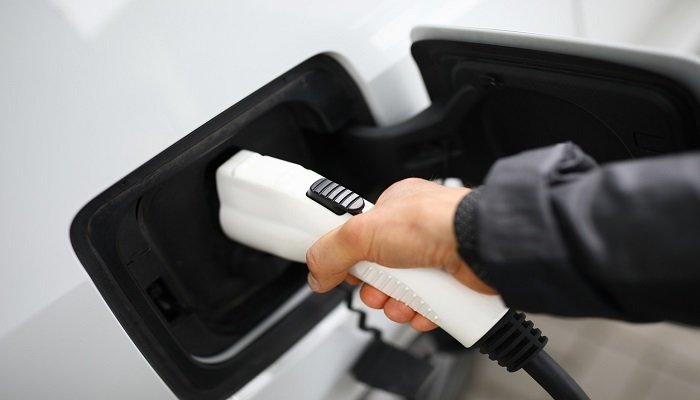
A hybrid electric car has a traditional internal combustion engine and an electric motor powered by a lithium-ion battery pack. There are generally two types of electric hybrid vehicles, and these include a plug-in electric hybrid (PHEV) and self-charging hybrid.
Self-charging hybrids do not have large battery packs and therefore the amount of battery power they have available for journeys is typically limited to several minutes. The battery is used a low speed and to supplement power from the petrol engine for accelerations. Vehicle CO² levels are low (110g/km) and the miles-per-gallon achieved can be in the 45-55mpg range or higher.
Plug-in hybrids (PHEVs) have a similar combination of an ICE petrol engine, electric motor, and lithium battery pack. These types of vehicles require an electric vehicle connection point through which to charge the battery if the fuel economies are to be reached. A PHEV can run on petrol power if there is no battery charge but the miles per gallon achieved will be that of a typically petrol-fuelled car. CO² levels can be dramatically lower than self-charging hybrids and less than 40g/km.
A full charged PHEV can reach ranges of around 30-35miles using only electricity form the battery up to 60-70mph. Petrol power is only used for longer distances or for greater acceleration. This means that for most work or leisure related journeys including commuting, most trips can be completed on electric power. Some PHEV vehicles can also use their petrol engines to charge their batteries which can be useful at times but will reduce the mpg achieved. With daily charging, either at home or work or both a typical PHEV can reach mpg levels of 100 miles or more per gallon. For most vehicles, their controls can be set as to which model of power to use, how much battery power is to be used, speed limits for transfer and so forth.
The quoted metrics differ between vehicle manufacturers and models and are given here as a guide only. Typical manufacturers of self-charging hybrids including Toyota and Lexus. Most other ICE-based car manufacturers offer PHEV versions including BMW and Volvo.
Electric vehicles use only power stored in their battery sets. The range of a standard battery is around 180-280 miles with extended range batteries available as build-in options for over 350 miles and more.
Electric vehicles can travel further on an electric charge than a self-charging or plug-in hybrid PHEV but will eventually require a recharge. The two most convenient points of connection being home and workplaces. Full recharges can take up to 5 hours or more dependent upon how discharged the battery is at the time of connection.
Most motorway services and retail parks now EV charger connection areas with chargers offering standard and fast boost charging. This allows an EV drive, whether a fully electric or PHEV to take time out of journey and plan for their recharging. Apps, satellite navigation and websites provide routes to the nearest charging points allowing journeys to be planned well in advance or an emergency recharge point driven too quickly.
With a full EV car fuel range is measured in miles (or kilometres) and the power usage in kilowatt hours (kwh).
For most users, a vehicle is their most significant purchase outside of their homes. However, cars do tend to be depreciating assets and so it is important to consider the overall lifetime costs of any vehicle including running and service costs.
Any car will require regular servicing, but petrol and diesels will require more than a full electric vehicle. Typically filters and oils require replacement between 10-15k miles. Diesel will give a higher miles per gallon than a petrol engine but with higher CO² levels and therefore one also needs to consider road tax, congestion, and other pollution-related taxes.
An advantage of plug-in hybrid and full electric vehicles is that they can make use of locally generated or stored electricity. This includes solar PV and energy storage systems. Coupled with a low-priced energy provider (preferably using renewables) and the cost of per mile could be less than 5p (£0.05) for an electric vehicle.
Tesla appears to be the front runner in terms of electric vehicles but many of the ‘traditional’ car manufacturers are starting to offer fill EV alternatives including Volkswagen, Audi, and BMW.
For more information see:
https://www.buyacar.co.uk/cars/economical-cars/electric-cars/650/cost-of-running-an-electric-car
Perhaps a final point to note in whether to stick with an IEC car, go PHEV or fully electric is to consider practicality. Running and service costs aside, a PHEV or electric vehicle can be purchased ahead of other investments in your home or workplace i.e., the installation of solar power PV and battery energy storage. As the UK transitions to a low carbon economy, we can expect more incentives for EVs and these compatible solutions in the future. Whichever version you choose, please do consider carry capacity and in particular boost space.
In a pure EV model, the battery sets are build-into the floor space of the entire vehicle. In a PHEV vehicle, boost space may be limited as the lithium batteries are placed under the rear boot area and can limit capacity by around 100 litres or more compared to an ICE equivalent.
Please contact our projects team for more information on our EV Charger Connection Points including pricing and options.